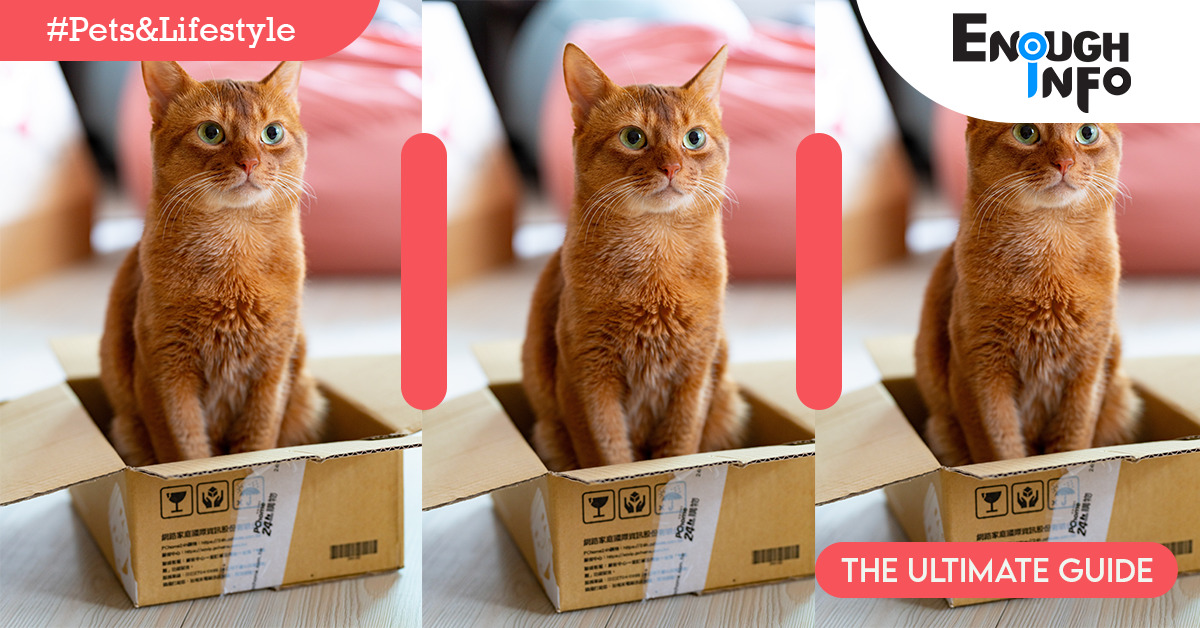How To Train A Cat To Use A Litter Box

How To Train A Cat To Use A Litter Box: Cats are known for their independent nature and natural instinct to use a litter box for their bathroom needs. However, not all cats are automatically inclined to use a litter box, especially kittens or cats transitioning from outdoor environments. Maintaining a clean and peaceful home requires training your cat to use a litter box. EnoughInfo.com
Read Also: How To Calm A Sexually Excited Dog

One of the most rewarding elements of cat ownership is how fast cats adjust to house training. Cats are reliably going to their litter boxes well before most pups learn where they should go potty, making life easier for everyone at home. Mother cats are commonly thought to educate their kittens to use a litter box, however, this is not always the case. Whether you have recently adopted a kitten or have a cat of any age, you will need to train it to use the litter box. How To Make A Homemade Face Mask For Acne
Gather Your Materials Before You Begin
You will need the following things before learning how to litter train a cat:
- The litter box
- Cat faeces
- Litter rake
Litter boxes come in a range of shapes and sizes, ranging from covered spaces to corner-shaped boxes that maximise room and privacy. Similarly, litter comes in a variety of styles. Clumping litter, which bonds when moist (forming a clump), is by far the most popular and convenient. Finally, a sifting litter scoop is a useful tool because it allows you to lift the mess rather than changing the litter every day. How To Paint A Portrait With Acrylics(Step By Step)
Furthermore, litter boxes vary in size depending on your feline’s breed, age, and weight. Choose a litter box that is at least one and a half times the length of your cat. This tip will allow your pet to turn around entirely and dig comfortably in numerous places.
A Comprehensive Guide: How to Train a Cat to Use a Litter Box

In this comprehensive guide, we will explore the step-by-step process of training a cat to use a litter box successfully.
1. Selecting the Right Litter:
Selecting the appropriate litter box is the first step towards successful litter box training. Select a box that is large enough for your cat to comfortably move around in and has low sides for easy access. Consider the material of the litter box (plastic or covered), as some cats may prefer an open box for a more spacious feel. Additionally, ensure that the litter box is easily accessible and placed in a quiet and private area of your home. How To Paint A Portrait With Watercolor Pencils
2. Choosing the Right Litter Box:
Choosing the right litter is crucial, as cats have different preferences for texture and scent. Start by using a clumping litter, as it is easier to clean and provides a more comfortable experience for your cat. Avoid scented litters initially, as some cats may find the fragrance overwhelming. Gradually introduce scented litters if desired, but always observe your cat’s reaction and switch back if necessary.
Read Also: How To Train A Dog To Shake Hands
3. Introducing the Litter Box:
Place the litter box in a designated area where your cat spends most of its time. Introduce your cat to the litter box by gently placing it inside. Allow your cat to explore and sniff the litter box at its own pace. If your cat shows signs of fear or discomfort, do not force it. Instead, provide positive reinforcement, such as treats or praise, when your cat approaches or investigates the litter box.
4. Encouraging the Use of the Litter Box:
Observe your cat’s behavior and body language for signs that it needs to eliminate. These signs may include restlessness, sniffing around, or squatting. When you notice these signs, gently place your cat in the litter box. If your cat starts to eliminate in the litter box, provide positive reinforcement and praise. Repeat this process consistently to reinforce the association between the litter box and the act of elimination.
5. Maintaining a Clean Litter Box:
Cats are generally clean animals and prefer using a clean litter box. Regularly scoop the litter box to remove clumps and feces, ideally on a daily basis. Cats may avoid a dirty litter box, so keeping it clean will encourage consistent litter box usage. Additionally, replace the litter entirely every 1-2 weeks to maintain freshness.
6. Handling Accidents:
During the training process, accidents may happen. If you catch your cat eliminating outside the litter box, do not punish or scold it. Instead, calmly interrupt the behavior and gently place the cat in the litter box. Clean up any accidents promptly using an enzymatic cleaner to remove the scent and discourage repeat incidents. Remember, positive reinforcement and consistency are key to successful training. How To Remove Stains From Carpet(The Ultimate Guide)
7. Troubleshooting:
If your cat continues to have accidents or shows reluctance to use the litter box, consider the following troubleshooting tips:
a. Ensure the litter box is easily accessible and in a quiet, private area.
b. Experiment with different litter types to find the one your cat prefers.
c. Provide multiple litter boxes in multi-cat households.
d. Rule out any potential medical issues by consulting a veterinarian.
8. Gradual Transition for Outdoor Cats:
If you are transitioning an outdoor cat to using a litter box, it may require a more gradual process. Start by placing the litter box near the cat’s usual outdoor elimination spot. Gradually move the litter box closer to the desired indoor location over time. Provide positive reinforcement and praise when the cat uses the litter box correctly. It may also help to sprinkle a small amount of soil or outdoor dirt in the litter box to mimic the outdoor environment initially.
Read Also: How To Calm A Cat In Heat(The Ultimate Guide)
9. Consistency and Patience:
Training a cat to use a litter box requires consistency and patience. Follow a consistent routine, provide positive reinforcement, and avoid punishing or scolding your cat. Each cat is unique, and the training process may vary in duration. Some cats may learn quickly, while others may take more time. Stay patient, observe your cat’s progress, and make adjustments as needed.
10. Maintaining Litter Box Hygiene:
Regularly maintaining the cleanliness of the litter box is crucial for your cat’s health and continued usage. In addition to scooping the litter box daily, perform a thorough cleaning of the litter box at least once a month. Empty the litter, wash the box with mild soap and warm water, and dry it before adding fresh litter. This helps prevent odors and ensures a pleasant environment for your cat.
11. Providing Environmental Enrichment:
Incorporate environmental enrichment to keep your cat mentally stimulated and content. Provide scratching posts, toys, and vertical spaces for climbing. Engage in interactive play sessions with your cat to prevent boredom and reduce stress. A mentally and physically stimulated cat is more likely to use the litter box consistently. How To Potty Train A Toddler (The Ultimate Guide)
12. Seeking Professional Help:
If you have diligently followed the training steps and your cat continues to have consistent litter box issues, it may be beneficial to consult with a veterinarian or a professional animal behaviorist. They can assess any underlying medical conditions or behavioral issues that may be contributing to the problem and provide specialized guidance.
Read Also: How To Remove Pet Hair From Furniture
FAQs & Answers on How To Train A Cat To Use A Litter Box
1. At what age should I start litter box training my kitten?
It is recommended to start litter box training your kitten around 3 to 4 weeks of age. At this stage, kittens begin to develop their motor skills and can start using a litter box with guidance from their mother or human caretaker.
2. What should I do if my cat refuses to use the litter box?
If your cat is consistently refusing to use the litter box, there could be underlying reasons such as medical issues or behavioral problems. It is important to rule out any potential health concerns by consulting a veterinarian. If no medical issues are found, consider consulting with a professional animal behaviorist who can provide guidance and assistance in addressing the behavioral aspect of the problem. How To Create A Budget For Retirement
3. Can I use multiple litter boxes for multiple cats?
Yes, if you have multiple cats, it is recommended to provide multiple litter boxes. The general guideline is to have one litter box per cat, plus an additional one. This ensures that each cat has access to a litter box and helps prevent territorial disputes or overcrowding of a single litter box.
4. How often should I change the litter in the litter box?
It is recommended to scoop the litter box daily to remove clumps and feces. Additionally, the litter should be completely replaced every 1 to 2 weeks to maintain cleanliness and freshness. However, if you notice odors or if the litter becomes heavily soiled before that time, it is advisable to change it more frequently.
5. Can I use a covered litter box for my cat?
Some cats may prefer the privacy and enclosed space of a covered litter box, while others may feel confined or trapped. It is important to observe your cat’s behavior and preferences. If your cat shows signs of discomfort or avoids using a covered litter box, consider switching to an open box to provide a more comfortable and accessible environment.
6. How long does it usually take to train a cat to use the litter box?
The time it takes to train a cat to use the litter box can vary. Some cats may learn quickly within a few days or weeks, while others may require several weeks or even months. Consistency, positive reinforcement, and patience are key during the training process. If you encounter challenges, it is important to remain persistent and seek professional guidance if needed.
7. Can I use sand or other materials instead of cat litter?
While cat litter is the most commonly used material for litter boxes, some cats may have preferences for other textures such as sand or shredded paper. However, it is important to choose materials that are safe, absorbent, and easy to clean. Avoid using clumping materials like sand, as they can clump in the cat’s digestive system if ingested.
8. Is it necessary to keep the litter box in a specific location?
It is recommended to place the litter box in a quiet and private area of your home. Cats prefer to have some privacy when using the litter box. Avoid placing it in high-traffic areas or near noisy appliances that may startle or disturb your cat. Additionally, ensure that the litter box is easily accessible for your cat to find and use.
Read Also: How to Train a Puppy to Sit (Step-by-Step Guide)
Conclusion:
Training a cat to use a litter box is a process that requires patience, consistency, and understanding. By selecting the right litter box and litter, introducing the litter box gradually, providing positive reinforcement, and maintaining cleanliness, you can successfully train your cat to use the litter box. Remember, each cat is unique, and the training process may vary. With love, patience, and a proactive approach, you can create a positive litter box experience for your feline companion, ensuring a clean and harmonious living environment for both of you.
Recommended;
How To Potty Train A Toddler (The Ultimate Guide)
How To Make A Homemade Natural Cleaning Solution




